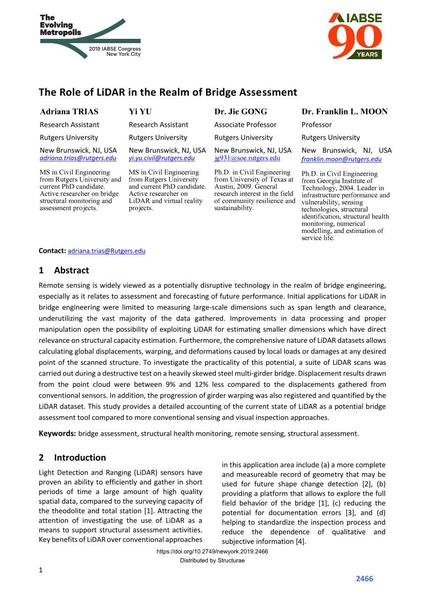The Role of LiDAR in the Realm of Bridge Assessment

|
|
|||||||||||
Détails bibliographiques
| Auteur(s): |
Adriana Trias
(Rutgers University)
Yi Yu (Rutgers University) Jie Gong (Rutgers University) Franklin L. Moon (Rutgers University) |
||||
|---|---|---|---|---|---|
| Médium: | papier de conférence | ||||
| Langue(s): | anglais | ||||
| Conférence: | IABSE Congress: The Evolving Metropolis, New York, NY, USA, 4-6 September 2019 | ||||
| Publié dans: | The Evolving Metropolis | ||||
|
|||||
| Page(s): | 2466-2470 | ||||
| Nombre total de pages (du PDF): | 5 | ||||
| DOI: | 10.2749/newyork.2019.2466 | ||||
| Abstrait: |
Remote sensing is widely viewed as a potentially disruptive technology in the realm of bridge engineering, especially as it relates to assessment and forecasting of future performance. Initial applications for LiDAR in bridge engineering were limited to measuring large-scale dimensions such as span length and clearance, underutilizing the vast majority of the data gathered. Improvements in data processing and proper manipulation open the possibility of exploiting LiDAR for estimating smaller dimensions which have direct relevance on structural capacity estimation. Furthermore, the comprehensive nature of LiDAR datasets allows calculating global displacements, warping, and deformations caused by local loads or damages at any desired point of the scanned structure. To investigate the practicality of this potential, a suite of LiDAR scans was carried out during a destructive test on a heavily skewed steel multi-girder bridge. Displacement results drawn from the point cloud were between 9% and 12% less compared to the displacements gathered from conventional sensors. In addition, the progression of girder warping was also registered and quantified by the LiDAR dataset. This study provides a detailed accounting of the current state of LiDAR as a potential bridge assessment tool compared to more conventional sensing and visual inspection approaches. |
||||
